DEPARTMENT OF CELL PHYSIOLOGY
We have developed new approaches, based on two-photon excitation microscopy, to the study of neurons and secretory cells. The application of these approaches has provided important insight into
(1) the structure-function relations of central synapses and
(2) the mechanisms of exocytosis in both neurons and secretory glands such as pancreatic islets and acini.
By further exploring the possible combination of two-photon excitation microscopy and novel caged compounds, patch-clamp methods, and molecular biological techniques, this laboratory aims to elucidate the molecular and cellular basis of synaptic and secretory cell function (Figs. 1-4).
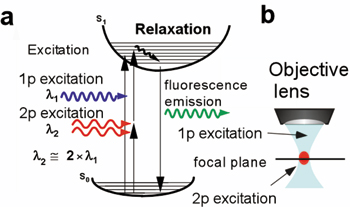 |
|
Figure 1. Two-photon excitation microscopeUsing infrared femto-second laser, two-photon excitation of molecules can be elicited by simultaneous absorption of two photons (a) at the focal point of an objective lens (b). Two-photon excitation imaging has deep tissue penetration, little out-of-focal light absorption and least phototoxic effects. Thus, it is most suitable for investigating molecular and cellular events within thick intact tissues. In addition, it allows simultaneous multi-color imaging and fluorescence correlation measurement. We have shown that such measurement can resolve exocytotic fusion events at nanometer resolution in the islet of Langerhans (Science 297(2002)1349). |
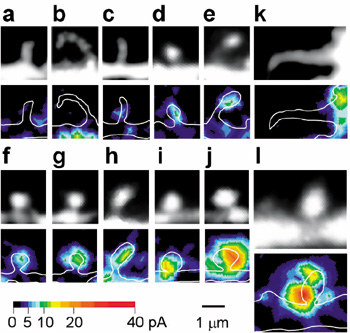 |
|
Figure 2. Structure-function relationship of dendritic spinesWe have established the methodolgy that enables focal application of glutamate using the two-photon excitation microscope, and revealed that glutamate sensivity is highly correalted with spine head volume in cerebral cortex (Nature Neurosci. 4(2001)1086). The strucure-function relationship suggests that memory is stored as a structural form in the cortical neuronal networks. |
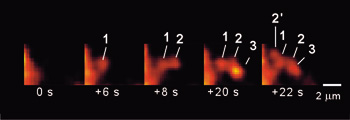 |
|
Figure 3. Sequential exocytosis The deep tissue penetration of two-photon excitation imaging has revealed sequential progression of exocytosis deep into the cysosol in exocrine glands (Nature Cell. Biol. 3 (2001) 253). |
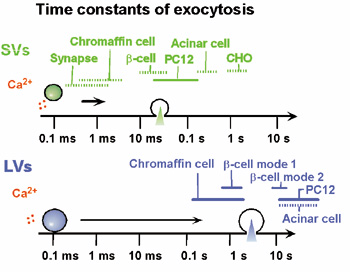 |
|
Figure 4. Diversity in the rate of exocytosisThe rates of exocytosis exhibit marked diversity among different cell and vesicle types. This diversity is physiologically relevant and reflects the existence of various fusion-ready states of secretory vesicles at the plasma membrane (Trends Neurosci. 22 (1999) 88). |
Staff
 |
Professor:
KASAI, Haruo, MD, PhD
1981 Graduated from the University of Tokyo, Faculty of Medicine. 1985 Completed doctoral course in Medicine at the University of Tokyo. 1988 Humboldt Fellow at the Max-Planck Institute. 1990 Research Associate and 1993 Associate Professor at the University of Tokyo. 1999 Professor, NIPS.
Specialty: Cell Physiology and Neurophysiology |
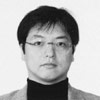 |
Assistant Professor:
NEMOTO, Tomomi, PhD
1991 Graduated from the University of Tokyo, Faculty of Science. 1996 Completed the doctoral course in applied physics at Tokyo Institute of Technology, Graduate School of Science and Engineering. 1996 Research Fellow of RIKEN. 1997 Research Fellow of the University of Tokyo. 1999 NIPS. 2001 doubled as a researcher, PREST, JST.
Specialty: Cell Physiology and Biophysics |
 |
Assistant Professor:
TAKAHASHI, Noriko, MD, PhD
1992 Graduated from the University of Tokyo, Faculty of Medicine. 1994 Clinical Fellow of Internal medicine at the University of Tokyo. 1998 Completed doctoral course in medicine at the University of Tokyo. 1998 JSPS Research Fellow . 2000 Research Associate, NIPS.
Specialty: Cell Physiology and Endocrinology |
 |
Assistant Professor:
MATSUZAKI, Masanori, PhD
1994 Graduated from the University of Tokyo, Faculty of Science. 2001 Completed the doctoral course in Medicine at the University of Tokyo. 2002 Research Associate, NIPS.
Specialty: Neuroscience |
All of the cell functions are performed or supported by operation of channels (ion and water channels) and transporters (carriers and pumps) located on the membrane. The objectives of our division work are to elucidate molecular mechanisms of most general cell activities, such as volume regulation, absorption/secretion and environmental signal reception, to clarify roles of channels, transporters and receptors in these fundamental functions from the viewpoint of integrative biology, and to throw the light on the relationship between these malfunctions and diseases or cell death, as well as to study the multifunctionality of channel and transporter during cell functions or malfunctions.
The main subjects of our current research are as follows:
(1) "Molecular mechanisms of cell volume regulation and their physiological roles": Most cells regulate their cell volume even under anisotonic conditions. In the volume regulation mechanisms, a number of channels, transporters and receptors are involved (Fig. 1).
We are investigating to identify volume-regulatory membrane machineries, including the volume-sensitive anion channel, and to clarify their physiological roles.
(2) "Induction mechanisms of apoptotic, necrotic and ischemic cell death": Dysfunction of cell volume regulation is associated with necrotic and apoptotic cell death (Fig. 2) which is coupled to persistent swelling (necrotic volume increase: NVI) and shrinkage (apoptotic volume decrease: AVD). Our aim is to pioneer the new field of ‘PHYSIOLOGY OF CELL DEATH’ through elucidation of the mechanisms of cell volume regulation and their dysfunction. We are attempting to focus our studies on the mechanisms of ischemic cell death of brain neurons and cardiac myocytes.
(3) "Mechanisms of multifunctionality of ion channels": Channels are multifunctional proteins involved not only in ion transport and electric signal generation but also in sensors for environmental factors and regulators for other channels/transporters. We aim at discovering a new function of ion channels, elucidating the molecular mechanisms. CFTR and ATP channels are our current interest in this regard.
(4) "Mechanisms of secretion and absorption in gastrointestinal cells":Activities of channels and transporters are prerequisites to functions in solute-absorbing enterocytes, Cl--secreting enterocytes, gastric acid-secreting parietal cells, insulin-secreting bcells, and so on. We are investigating their roles.
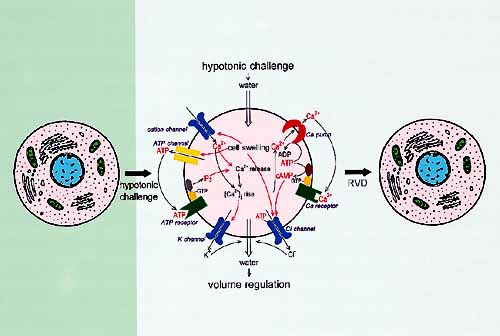
Fig. 1 Molecular mechanism of the regulatory volume decrease (RVD).
[after Okada et al. 2001, J. Physiol. 532, 3-16]
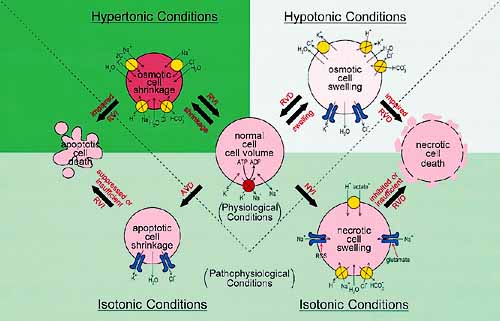
Fig. 2 Roles of channels and transporters in the induction of apoptotic volume decrease (AVD) and apoptotic cell death as well as in that of necrotic volume increase (NVI) and necrotic cell death. [after Okada et al. 2004, Pflüers Arch. 448, 287-295]
Staff
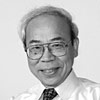 |
Professor:
OKADA, Yasunobu, MD, PhD
1970 Graduated from Kyoto University, Faculty of Medicine. 1974 Instructor and 1981 Assistant Professor, Kyoto University, Faculty of Medicine. 1992 Professor, NIPS.
Speciality: Molecular and Cellular Physiology |
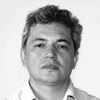 |
Associate Professor:
SABIROV, RAVSHAN, PhD
1980 Graduated from Tashkent State University, Graduated from Chemistry. 1986 Completed the doctoral course in Biophysics, Institute of Biochemistry, Uzbek Academy of Sciences. 1987 Associate Professor, Physiology and Biophysics, Uzbek Academy of Sciences. 1999 Associate Professor, NIPS.
Speciality: Biophysics and Cell Physiology |
 |
Assistant Professor:
KASHIHARA, Yasuhiro, PhD
1976 Graduated from Toyama University, Faculty of Science. 1983 Completed the doctoral course in Science, Kyushu University. 1983 Research Associate, NIPS.
Speciality: Neurobiology |
 |
Assistant Professor:
SHIMIZU, Takahiro, PhD
1995 Graduated from Toyama Medical and Pharmaceutical University, Faculty of Pharmaceutical Sciences. 2000 Completed the doctoral course in Life Science, the Graduate University for Advanced Studies. 2000 Research Fellow, NIPS. Apr 2002 JSPS Postdoctoral Fellow. Jul 2002 Research Associate, NIPS.
Speciality: Cell Physiology |
 |
Assistant Professor:
TAKAHASHI, Nobuyuki, PhD
1993 Graduated from Kyoto University, Faculty of Agriculture. 1999 Completed the doctoral course in Medicine, Kyoto University. Apr 1999 AIST Research Fellow. Oct 1999 BRAIN Research Fellow. Dec 2002 Research Associate, NIPS.
Speciality: Cell Biology |
 |
JSPS Postdoctoral Fellow:
DUTTA, Amal Kumar, PhD
1991 Graduated from Rajshahi University, Faculty of Medicine and Surgery. 2003 Completed the doctoral course in Life Science, the Graduate University for Advanced Studies. Apr 2003 MEXT Postdoctoral Fellow. Apr 2004 JSPS Postdoctoral Fellow.
Speciality: Cell Physiology |
 |
Research Fellow:
MANABE, Kenichi, PhD
2002 Completed the doctoral course in Life Science, the Graduate University for Advanced Studies. Nov 2002 JST Research Fellow. Nov 2003 Research Fellow, NIPS.
Speciality: Cell Physiology |
 |
MEXT Postdoctoral Fellow:
URAMOTO, Hiromi
1990 Graduated from Japan women's University, Department of Food and Nutrition. 2002 Left the doctoral course in Life Science, the Graduate University for Advanced Studies. Nov 2002 JST Research Fellow. Apr 2004 MEXT Postdoctoral Fellow.
Speciality: Cell Physiology |
 |
JST Research Fellow:
INOUE, Hana, PhD
1997 Graduated from Waseda University, Faculty of Education. 1999 Completed the master course in Science and Engineering, Waseda University. 2003 Completed the doctoral course in Life Science, the Graduate University for Advanced Studies. 2003 JST Research Fellow.
Speciality: Cell Physiology |
In this division, we are trying to clarify how cell-cell adhesion signals are transmitted to the nucleus and how these signals regulate the cell proliferation and differentiation in general. These studies are important for better understanding the molecular mechanism not only behind the development of multi-cellular organisms but also behind the tumorigenesis and metastasis of cancer cells.
First, we developed an isolation procedure for adherens junctions, where cadherins work as major cell adhesion molecules, and using this fraction we identified and examined several novel adherens junction proteins. Interestingly, many of these proteins have been shown to function as tumor suppressors, suggesting that the studies along this line will clarify the relationship between the cell-cell adhesion signals and the regulation of cell proliferation and differentiation.
Second, we noticed that tight junctions are also enriched in the above fraction, and using this fraction we successfully identified two distinct types of adhesion molecules, occludin and claudin, which work at tight junctions. These studies will open a new way to analyze the molecular mechanism behind the compart-mentalization in multi-cellular organisms in general.
Staff
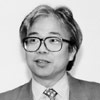 |
Professor:
TSUKITA, Shoichiro, MD, PhD
1977 Graduated from University of Tokyo, Faculty of Medicine. 1981 Completed the doctoral course in Medicine, University of Tokyo. 1981 Lecturer, University of Tokyo, Faculty of Medicine. 1985 Director, Tokyo Metropolitan Institute of Medical Science. 1989 Professor, NIPS. 1994 Professor, Kyoto University, Faculty of Medicine. 2002 Concurrent Professor NIPS.
Speciality: Cell Biology |
 |
Associate Professor:
KAGAWA, Tetsushi, PhD
1987 Graduated from Osaka University Faculty of Science. 1992 Graduated from the doctoral course at Osaka University, PhD. 1993 Research Fellow, NIPS. 1994 Research Associate, NIPS. 1996-1998 Research Associate, the Salk Institute for Biological Studies. 2002 Associate Professor, IMEG, Kumamoto University. 2003 Adjunct Associate Professor, NIPS.
Speciality: Molecular Neurobiology |
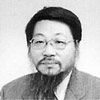 |
Assistant Professor:
HIGASHI, Akifumi, PhD
1968 Graduated from Tohoku University, Faculty of Science. 1973 Completed the doctoral course in Science, the University of Tokyo. 1975 Research Associate in Physiology, the University of Tokyo, Faculty of Medicine. 1977 Research Associate, NIPS.
Speciality: Neurophysiology, Neurochemistry |
|





















